6
Tianhong Shi
Introduction
Educators are fortunate to be situated in this time of human history. In the 20 years since the declaration of the Decade of the Brain – 1990s (Library of Congress, 2000), neuroscientists have made great strides in learning how human brains function. Educational technology has witnessed rapid advancement as well. With a simple keyword search, the Internet provides abundant resources on almost anything a person would like to know. With just one finger touch on a device, one can easily hold a face-to-face conversation with another person or a group of people on other continents. In 2019, it was estimated that 67% of people worldwide own a mobile phone (Statista, 2019). Teams of early educational technology adopters are developing applications of augmented reality, virtual reality, and mixed reality for engaging user experiences (Georgieva, 2013). However, such abundant information and technological possibilities also pose challenges to educators, in the form of loss of focus and choice difficulty. This chapter proposes a neuroscience-informed pedagogy with Universal Design for Learning (UDL) guidelines, in an effort to ensure quality instructional design for the purpose of learning success for all learners.
Wheelchairs and UDL
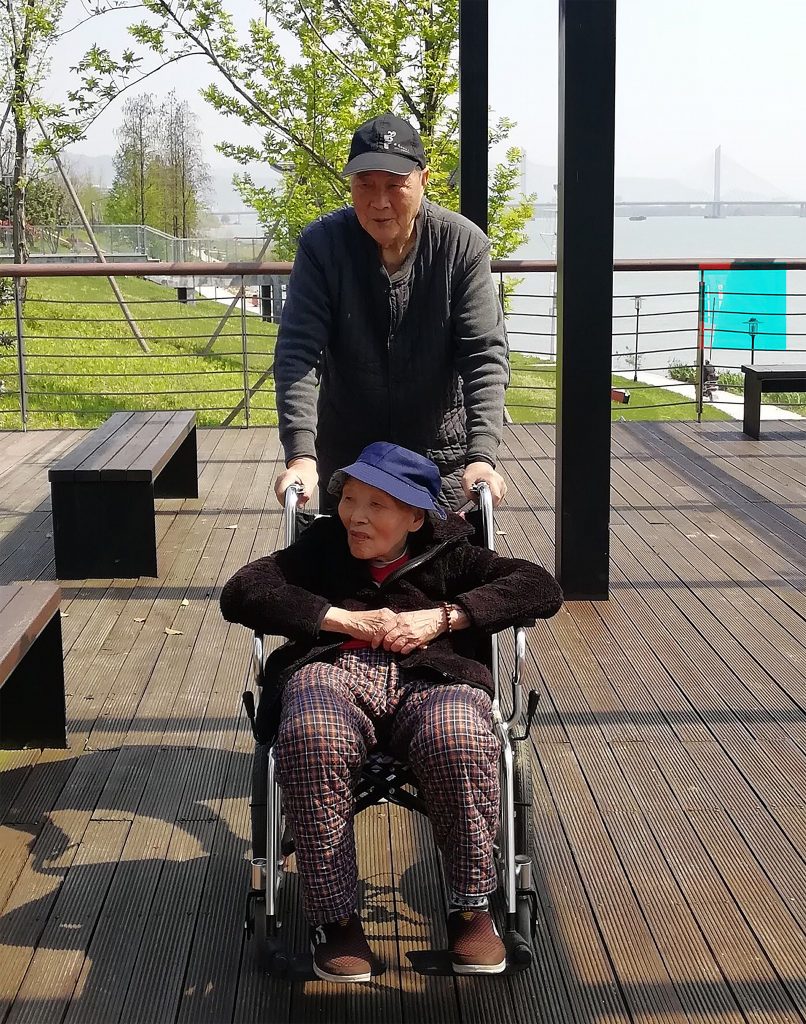
Image 1. Ninety-one-year old Zhen’An Shi pushes his wife, Genglian Zhang, sitting in a wheelchair, for a Riverfront walk in Hangzhou, China, in Spring 2018.
In summer 2018, the author spent one month in China with her 91-year old father and 83-year old mother. Due to low mobility and a lack of energy, her parents use wheelchairs when they go out for a walk. And how thankful they were for the invention of wheelchairs! Without wheelchairs, many people would be forced to stay indoors all the time. On her flight back to the United States, the author watched the 2017 film Breathe, featuring the story of Robin Cavendish, a paralyzed British polio patient, one of the longest-lived responauts in Britain, a fervent advocate for disabled people, and a developer of medical aids. He was able to breathe using a mechanical ventilator, and moved around in and outside his house using a modified wheelchair with help and support from his wife and friends. As these examples show, wheelchairs have improved the quality of life for many people by improving their access to mobility.
Similarly, UDL aims to provide learners with improved, universal access to learning by removing barriers to learning.
Self-Directed Learning on UDL
In 2017 and 2018, as part of the first and second ID2ID program cohorts (a peer-mentoring program for instructional designers organized by Educause and Pennsylvania State University), the author and her mentees started to research the topic of UDL through book readings, a free online UDL training course created and facilitated by Eric Moore (Moore, 2017), web resources (CAST’s UDL website), and webinars. Following a period of intensive self-directed learning on UDL, the author encouraged online instructors at her institution to apply UDL principles in online courses they were developing at the moment. Six instructors adopted some UDL principles into their courses and provided positive feedback. The plus-one approach recommended by Thomas Tobin (Tobin, 2016, slide 9) was especially practical and successful in promoting and pioneering UDL implementations. Since then, the author has advocated for the use of UDL principles in all courses that she is involved with, for course design, development, and implementation.
UDL: What and Why
In 1984, a small team of education researchers (namely, Anne Meyer, David Rose, Grace Meo, Skip Stahl, and Linda Mensing) founded the Center for Applied Special Technology (CAST) and gradually refined the principles of UDL (CAST, n.d.). Meyer and Rose proposed the term Universal Design for Learning in their books Learning to read in the computer age (Meyer and Rose, 1999) and Teaching every student in the digital age: Universal Design for Learning (Rose and Meyer, 2002). CAST (2019) explains UDL as “a research-based framework for designing learning technologies for everyone.” CAST defines UDL principles as a practical tool for guiding course design to ensure that every learner succeeds, based on scientific insights into how humans learn (CAST, n.d.). There are three main principles of UDL:
- Multiple means of representation,
- Multiple means of engagement, and
- Multiple means of action and expression.
Using multiple means of representation, engagement, and expression, UDL strives to make content accessible to all learners, stimulate interests and motivation for learning, and provide a pathway for every learner to succeed (CAST, n.d.). By teaching students according to their individual needs, we make sure that every student succeeds and prepare them for the future, versus preparing for our own past by teaching them how we were taught (Novak, 2017).
“You don’t just get kids in the driver seat of learning; you get expert drivers once you use UDL” (McGrath, 2018). That is the benefit of using the UDL framework to guide any design of teaching and learning. And that is why educators across K–12 and higher education are promoting UDL.
UDL: Work in Progress
The concept of universal design came from universal design in architecture and the 1968 Architectural Barriers Act (Tobin & Behling, 2018). K–12 education was an early adopter, applying universal design to curriculum design. In the 1990s, CAST began to translate principles of universal design for the physical environment into a design for interactions in the elementary and secondary education systems. In the 2000s, adoptions of UDL in higher education started to appear (Tobin, 2016).
The past 20 years have seen widespread use of UDL in K–12, higher education, and online education, in the United States and globally: adopters include Harvard Education Review, various journals, the International Association for K–12 Online Learning, and the UDL Implementation and Research Network, with UDL champions in the United States, Canada, South America, Australia, New Zealand, Africa, Asia, and Europe (UDL-IRN International Summit, 2018). In 2015, “President Obama signed into law the Every Student Succeeds Act (ESSA), which replaces the widely criticized No Child Left Behind. And for the first time, the nation’s general K–12 education law defines and endorses Universal Design for Learning” (Berg, 2016). Also, Opportunity 8 in the Ed Tech Developers’ Guide (U.S. Department of Education, 2015) focuses on making learning accessible to all students and recommends the UDL framework from CAST.
Dr. James Basham and Jeff Diedrich co-founded the Universal Design for Learning Implementation and Research Network (UDL-IRN) in 2010 (Nelson & Basham, 2014; UDL Focus, 2010). UDL-IRN has held an annual summit conference for the past five years and has attracted on-site and online attendees from all around the world. UDL-IRN also has three Special Interest Groups (SIGs): Professional Development, UDL Implementation, and Higher Education. The Higher Education SIG is led by Eric Moore, Jodie Black, and Kate Snyder. The latest Higher Education SIG meeting worked on the goal of collecting real experiences, strategies, and results for addressing resistance to UDL in higher education. Eric Moore offers a free Massive Open Online Course (MOOC) titled “Implementing UDL on Canvas (K-12/HE)” (Moore, 2017).
Early adopters of UDL are actively shaping the future of higher education. Thomas J. Tobin and Kristen T. Behling co-authored a book titled Reach Everyone, Teach Everyone: Universal Design for Learning in Higher Education (2018). With relentless efforts from UDL pioneers and advocates, UDL implementation in both K–12 and higher education will continue to make improvements in training and prepare instructors at all levels to ensure learning success for all learners.
Neuroscience Foundations of UDL
As CAST founders were developing guiding principles for teaching and learning in the 1980s and 1990s, President George H. W. Bush designated 1990–1999 as the Decade of the Brain, and the Library of Congress and the National Institute of Mental Health were involved in enhancing public awareness of the benefits from brain research (Library of Congress, 2000). It is not surprising to see the coming of UDL in the late 1990s as heavily based on neuroscience and brain research.
Some key neuroscience discoveries that shaped the UDL principles include brain variability, neuroplasticity, the goal-driven brain, the importance of prior knowledge, and attention/curiosity/memory of the brain.
Brain Plasticity
In 1969, Professor Geoffrey Raisman introduced the term plasticity to describe the ability of the adult nervous system to make new synapses after injury (Fawcett, 2018). The idea of neuroplasticity was resisted fiercely until the Decade of the Brain in 1990s. As new ideas and supporting evidence arose, Dr. Raisman hoped that by understanding more about plasticity scientists might learn how to get people out of wheelchairs one day. In 1996, Raisman’s research team witnessed the repair of injury to the spinal cord in lab rats. In 2012, Dr. Pawel Tabakow, a neurosurgeon in Poland, Dr. Raisman, and their colleagues helped a Polish paraplegic firefighter to regain walking ability by inserting his olfactory nerve into his damaged spinal cord (Max, 2016).
By the end of the 1990s, the mounting neuroscientific evidence had led to increasing acceptance of neuroplasticity, and had revealed that the brain (at all ages) is highly responsive to environmental stimuli and that connections between neurons are dynamic and can rapidly change within minutes of stimulation (Volkow, 2010).
Erin Hoiland (n.d.) summarized four facts of neuroplasticity:
- Neuroplasticity includes several different processes that take place throughout a lifetime.
- Neuroplasticity has a clear age-dependent determinant.
- Neuroplasticity occurs in the brain under two primary conditions:
- During normal brain development (including developmental plasticity and plasticity of learning and memory in adulthood), and
- As an adaptive mechanism to compensate for lost function and/or to maximize remaining functions in the event of brain injury.
- The environment plays a key role in influencing plasticity.
Dr. Thomas Südhof (along with two others) received the Nobel Prize in Physiology or Medicine in 2013, for his work in exploring how neurons in the brain communicate with one another across gaps called synapses (Conger, 2013). Dr. Deann Ware, a former student of Dr. Südhof, wrote that,
“Our brain cells communicate with one another via synaptic transmission—one brain cell releases a chemical (neurotransmitter) that the next brain cell absorbs. This communication process is known as “neuronal firing.” When brain cells communicate frequently, the connection between them strengthens. Messages that travel the same pathway in the brain over and over begin to transmit faster and faster. With enough repetition, they become automatic. That’s why we practice things like hitting a golf ball—with enough practice, we can go on automatic pilot.” (Ware, 2013)
Dr. Angela Duckworth, in her book Grit (2018), proposes the following formula for success or achievement in any field: Talent X Effort X Effort = Achievement.
The formula suggests that effort counts double in terms of achievement. And the secret of effort and skill building, Duckworth continued, is deliberate practice, which is intentional and focused, with immediate, informed feedback for improvement, refining the process, reflecting, and trying the whole thing over again, until mastery-level performance is achieved. Duckworth’s idea came from her team’s interviews with many people in various fields. Interestingly, their summarized interview data supports Dr. Südhof’s discovery of neural communication patterns.
According to an ancient Chinese idiom, diligent practice makes up for one’s shortcomings. Practice is crucially important in learning success. If educators can provide students opportunities to practice, and engage them in practice, they are helping students learn success.
Applications of neuroplasticity:
- Even as adults, human brains are constantly growing as they are engaged.
- Deliberate practice of a targeted skill strengthens the skill and improves memory.
- Using different ways to learn the same concept or skill provides multiple pathways to the targeted concept or skill, thus building stronger connections for that concept or skill (CAST, 2018). The principle of multiple means of representation and the principle of multiple means of engagement can be traced back to the nature of how neurons communicate with each other.
- Frequent, formative feedback and opportunities for active learning create and strengthen the connections within the learning brain (CAST, 2018). The principle of multiple means of action and engagement can also be traced back to neuroplasticity.
Multiple means of expression can also be tied to neuroplasticity, because when educators create opportunities for learners to express their learnings in multiple ways, they are providing multiple pathways between neurons to achieve the same learning goal—building/strengthening a skill or concept to be learned.
Variability of the Human Brain—No Two Brains Are Alike
“The fact that people think or behave differently from one another is rooted in individual differences in brain anatomy and connectivity” (Mueller et al., 2013, p.586). The concept of neuro-variability is important for educators, because it serves as a reminder that learners do not have an isolated learning “style,” but instead rely on many parts of the brain working together to function within a given context. Variability is an important consideration for thinking about not just differences between students, but also those within students in different contexts (CAST, 2018).
Neuro-variability can be applied in UDL: Designing learning environments proactively for variability allows educators to anticipate and value the incredible strengths and diversity of their learners. Acknowledging that learners do not learn in one linear pathway, and creating opportunities for them to learn, engage, and express via multiple means, fosters expert learners who are purposeful and motivated, strategic and goal-directed, and resourceful and knowledgeable (CAST, 2018).
The Goal-Driven Brain
Brain actions can be habitual (stimulus-response) or goal-directed (Eryilmaz et al., 2017). The most common forms of goal-driven neural activity are the prospective evaluation of possible state (situation) and action outcomes rather than fixed stimulus–response rules. From a neuroscience perspective, goal-directed behavior is mediated by a network of highly interconnected brain structures that directly implement the why, what, when, where, and how of goal-directed actions: Why do I need to act? What do I need? Where and when can this be obtained? And how do I get it? (Verschure, Pennartz & Pezzulo, 2014).
There are different ways to design instructions to best fit the goal-driven brain. For example, learning goals for the entire course and for each module should be stated clearly and should be visible and easy to find. Instructors should explain why these goals were chosen for this course, and how achieving these goals will be beneficial to the learners. One of the standards in Quality Matters for online course design is aligning the learning objectives with the learning activities and the assessments, and making the learning objectives visible and accessible (Quality Matters, 2019).
Curiosity
When we are curious, our brain activity changes in ways that help us retain new information (Gruber, Gelman & Ranganath, 2014). Curiosity leads us to explore novel environments and objects even at the risk of leaving our shelter and decreasing our own safety level, when no explicit reward is ensured (Verschure et al., 2014).
Instructions can be designed that utilize learners’ curiosity in learning—for example, telling interesting stories about how the instructors or researchers became interested in a specific field of study (Eyler, 2018), or the hope or goal that has sustained them in their years of research and teaching. Or one might identify the gap between what learners already know and what the course learning objectives are and provide opportunities for learners to explore, learn, and teach themselves the target learning content that they are not familiar with yet.
Alternatively, a question might be asked to trigger students’ curiosity using the curiosity gap method: reveal just enough information to intrigue your learners. Too little information can make a situation bewildering, and too much robs the learner of the opportunity to explore a topic and learn for themselves. Demian Hommel, a geography instructor at Oregon State University, used a curiosity gap and interleaving instruction to get his Geo 106: Geography of the Western World class interested in the topic. He asked them “Are there too many people on the planet?” The next step is to have students discuss the question briefly, and to reveal, through a series of questions, that the current world population is around 7.7 billion (Shi, 2019). Next, students might be asked “What is the expected upper limit on human population?” and to write down the largest whole number in billions.
After revealing more information on how the world population has changed over the past 5000 years, one might ask students to choose one answer among the following: 8, 9, 10, 11, 12, 13, 14, or 15+ billion. After revealing more information on population crisis and shrinking societies, the question can be narrowed by asking students “What is the expected upper limit on human population? Choose one of the following: 10, 11, 12, or 13 billion.” Finally, the instructor could reveal the latest estimate of the limit by the United Nations: 10 billion.
The author of this chapter participated in a faculty training workshop where Demian demonstrated his use of the curiosity gap. Every attending participant became quite interested in the activity and in the technique itself. Other intriguing questions might be formulated to fit other subjects (such as non-renewable energy sources), using the curiosity gap.
Prior Knowledge
When it comes to learning anything new, learners possess knowledge, skills, beliefs, concepts, conceptions, and misconceptions that can significantly influence how they think about the world, approach new learning and go about solving unfamiliar problems (Wandersee, Mintzes, and Novak, 1994).
“Learners use what they already know to construct new understandings . . .. If students’ existing knowledge is not engaged, the understanding they develop through instruction can be very different from what their teacher may have intended; learners are more likely to construct interpretations that agree with their own prior knowledge even when those interpretations are in conflict with the teacher’s viewpoint” (National Research Council, 2002). Rosa and Galvão’s qualitative and exploratory research (2017) suggests that prior knowledge influences the study process, affecting individuals’ recognition of information, study speed, capacity for metacognitive articulation, and attitude before the teaching process. Instructors must consider information students need to assist students’ study process, and the form of support in a teaching situation. What a student already knows really matters in learning.
The Visual Brain
Many science topics involve complex and invisible processes that are challenging to explain in words due to symbolic correspondences of meaning to language. Educators have developed ways of representing these processes to enable and enhance student understanding, using external visual representations, such as diagrams, photographs, illustrations, flow charts, and graphs (Hegarty, Carpenter, & Just, 1990; Mayer, 1989).
“Visualizations help to draw inferences, find routes in maps, spot trends in graphs, imagine traffic flow or seasonal changes in light from architectural sketches and determine the consequences of movements of gears and pulleys in mechanical systems. With the help of arrows, visualizations can help learners depict the parts and configurations of systems, a range of kinds of forces as well as changes over time. Presenting such content only via language, without visualization, may be difficult” for learners to comprehend (Bobek & Tversky, 2016).
Jandhyala (2017) listed six reasons why visuals are the most powerful aspect of e-learning:
- Visual aids help learners store information longer.
- Visual aids make communication quicker and simpler.
- Visual aids increase comprehension.
- Visual aids act as stimulators for emotions.
- Visual aids drive motivation.
- Unsuitable visuals equal unhappy learners.
The Social Brain
According to the National Research Council (2002), social interaction is important for the development of expertise and metacognitive skills, and for the formation of the learner’s sense of self. Research demonstrates that opportunities for students to articulate their ideas to peers and to hear and discuss others’ ideas in the context of the classroom are particularly effective in bringing about conceptual change (Alexopoulou & Driver, 1996; Cobb, Wood, & Yackel, 1993; Kobayashi, 1994; Towns & Grant, 1997; Wood, Cobb, & Yackel, 1991).
A mentalizing network is a set of brain regions that support thinking about the thoughts, feelings, and goals of others. Humans’ natural social tendencies can be leveraged to improve learning, by making the content and process of education more social (Lieberman, 2012). Table 1 shows how neuroscience facts, brain functions, and UDL principles are aligned.
Summary Table: Aligning Neuroscience, Brain Functions, and UDL Principles
| Neuroscience: Variability of human brain, neuroplasticity, goal-driven or stimulus-driven, prior knowledge, curiosity, visual brain, and social brain | |||
| Brain functions | The why of learning, which aligns with affective networks of the brain: interest, effort, persistence, and self-regulation (CAST, 2018) | The what of learning, which aligns with recognition networks: perception, language and symbols, and comprehension (CAST, 2018) | The how of learning, which aligns with strategic networks: physical action, expression and communication, and executive function (CAST, 2018) |
| UDL principles | Multiple means of engagement | Multiple means of representation | Multiple means of action and expression |
Table 1. Alignment of neuroscience facts, brain functions, and UDL principles.
“The more we understand about our own learning and how it happens, the further we advance toward the ultimate goal: becoming expert learners” (CAST, 2018, p. 3). Understanding these key facts about the human brain helps teachers and instructional designers to design learning experiences that best utilize these brain characteristics. For example, in choosing content presentation, consider including things that are relevant to students’ past experiences, as a way to promote engagement.
Pedagogical Foundations of UDL: Inclusive Pedagogy
Much of the research on UDL focuses on pedagogical approaches for K–12 as opposed to adult higher education learning contexts. But the UDL principles and examples outlined in this chapter can be applied in both K–12 and higher education.
After reviewing the relevant literature, Loreman (2017) summarized that “Inclusive pedagogy is about providing for meaningful participation of all learners.” He also pointed out that inclusive pedagogy requires teachers to adopt a humble and introspective attitude, and inclusive pedagogy involves the judicious use of technology (Loreman, 2017).
UDL is a framework. It can be categorized under inclusive pedagogy because its principles and guidelines match those of inclusive pedagogy. Inclusive pedagogy requires a shift in teaching and learning, away from an approach that works for most learners existing alongside something “additional” or “different” for (some of) those who experience difficulties, and toward one that involves the development of a rich learning community constructed by learning opportunities that are made sufficiently available to everyone, so that all learners are able to participate in classroom life (Florian & Linklater, 2009).
Florian (2007) identified the challenge of inclusive pedagogy faced by teachers who wish to become more inclusive in their practice as how to respect as well as respond to human differences in ways that include learners in, rather than exclude them from, what is available in the daily life of the learning environment.
The following is a K–12 example: A student with cerebral palsy remains in the classroom for the full day but does not have opportunities to play with other children. There is some concern that the student’s language is not developing because he is not talking in the nursery. One might encourage the student with cerebral palsy to play with other students, and assess how the student uses his time in the play zone. In this case, the teacher noted that the student was able to talk when he wanted—when there was no pressure to do so (Rose & Meyer, 2002).
A higher education example: In the course BI 319: Critical Thinking and Communication in the Life Sciences at Oregon State University, students need to develop critical thinking skills and analytical writing skills. The instructor, Dr. Meta Landys, designed three big writing projects spread over different weeks of the 11-week term. To help students understand what was due which week and how these smaller assignments are related to the three big writing projects, Landys and the author created a visual calendar to help students see what is due when and how it all fits into the big picture (see Image 2 for illustration).
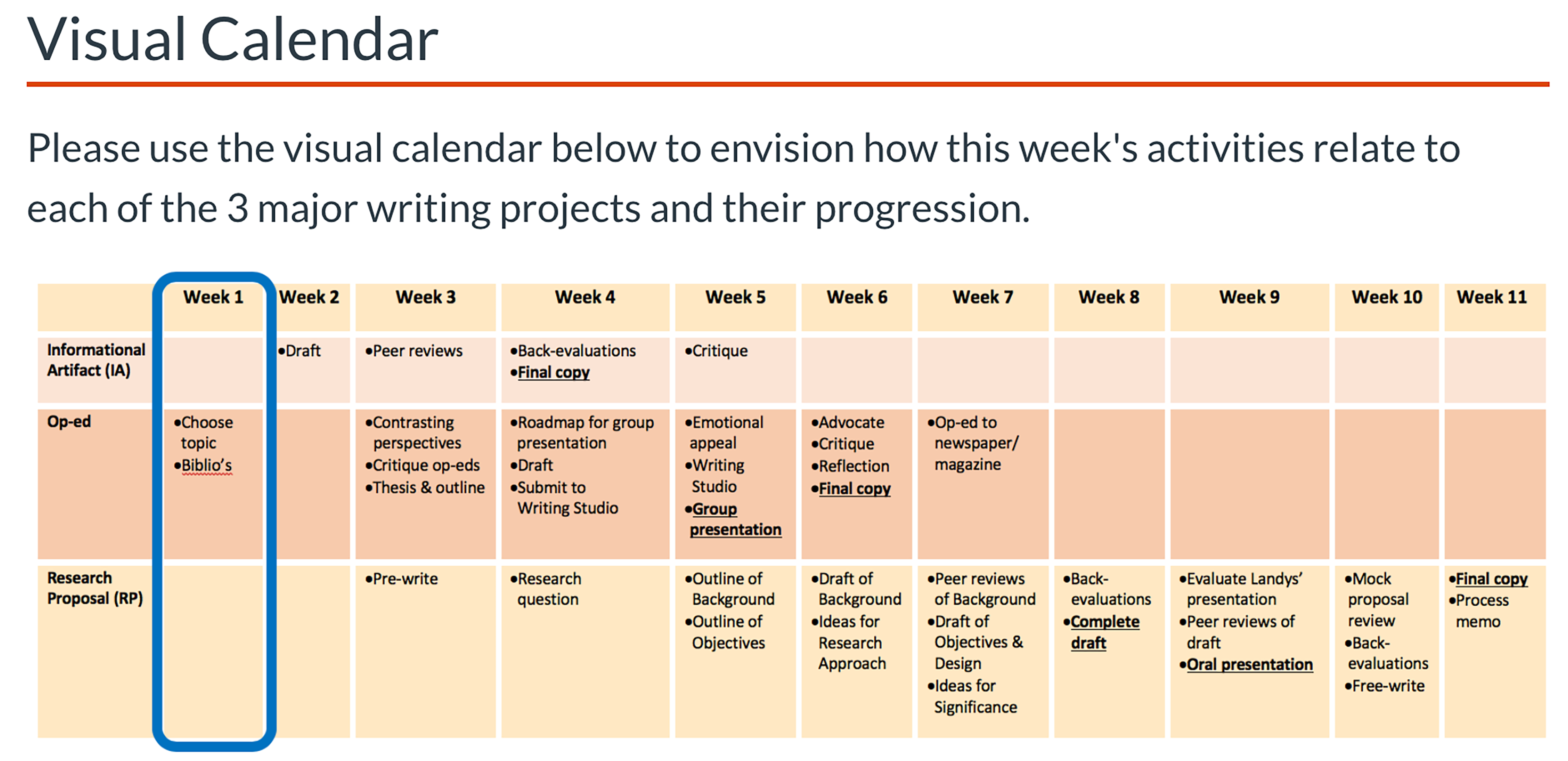
Image 2. Visual aid in Oregon State University online course BI 319: Critical Thinking in the Life Sciences. Visual calendar created by Dr. Meta Landys, instructor at Oregon State University.
Although inclusive pedagogy matches UDL in terms of goals and key approaches, inclusive pedagogy as a pedagogical approach is not clearly defined. Such vagueness makes it difficult to use inclusive pedagogy to guide the practical implementation of instructional design. Therefore, the author continues to search for a pedagogy that can guide inclusive design aimed at the success of all learners.
Neuroscience-Informed Pedagogy With UDL Principles
During the Online Learning Consortium’s 2018 workshop on Neuro, Cognitive, and Learning Sciences: Bring Theory to Practice (Part I), one of the facilitators, Dr. Kristen Betts, directed the author to an interesting article: “Informing Pedagogy Through the Brain-Targeted Teaching Model” (Hardiman, 2012). Hardiman proposed six steps in her brain-targeted teaching model:
- Establishing the emotional climate for learning.
- Creating the physical learning environment.
- Designing the learning experience.
- Teaching for mastery of content, skills, and concepts.
- Teaching for the extension and application of knowledge.
- Using evaluation as a valuable tool for enhancing learning and memory.
This model, as the title suggests, is based on neuroscience and brain research, and aims to provide pedagogical guidance. Compared to inclusive pedagogy, this model is much clearer in its role of providing guidance for instructional strategies. The model is also comprehensive in terms of its scope.
In looking for a tool to guide the implementation of quality instructional design, something concrete is needed for guidance, such as the UDL principles. Therefore, the author mixed this model of neuroscience-informed pedagogy with UDL to come up with a blended model that can be used to guide future instructional design.
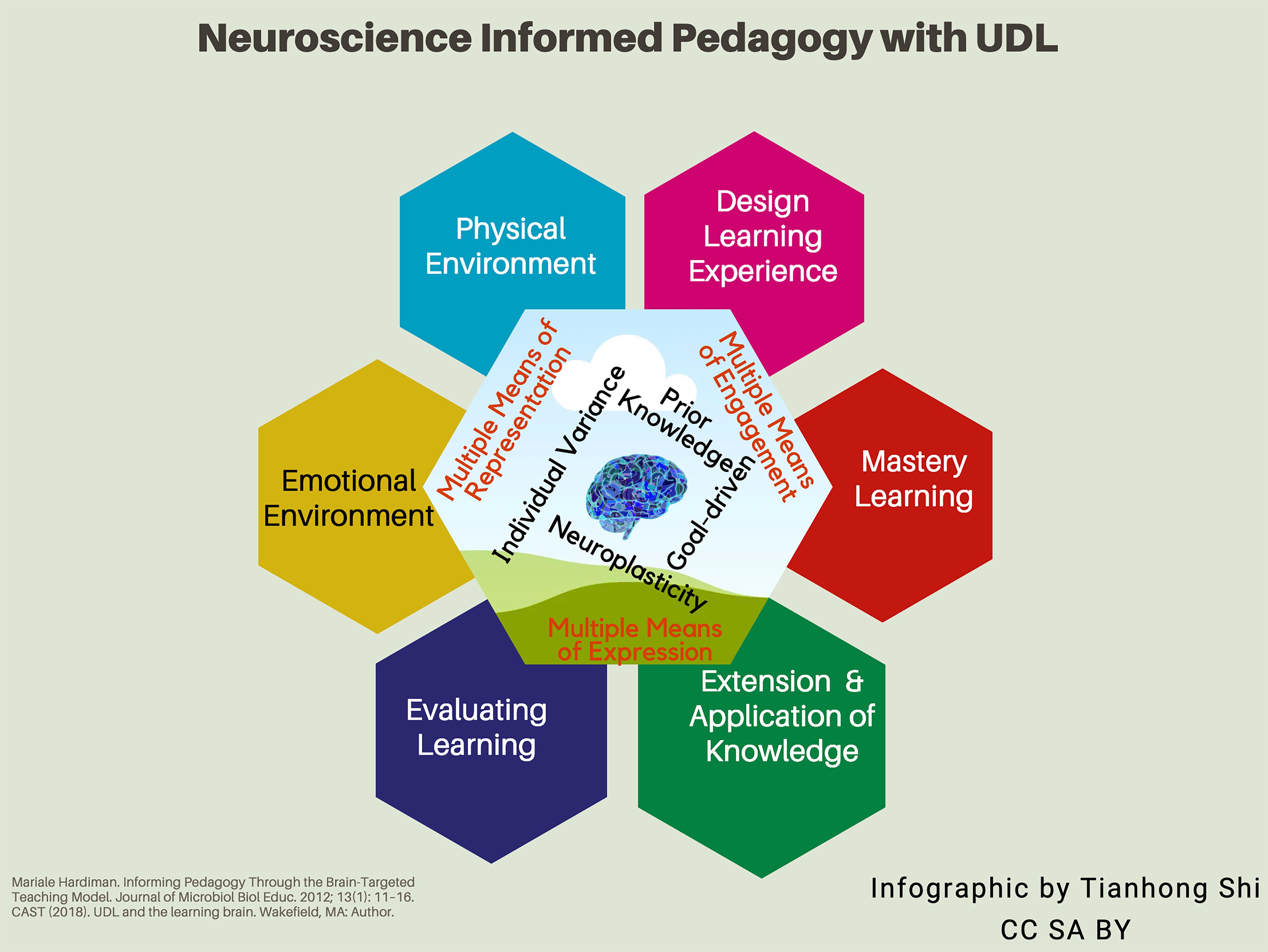
Image 3. Neuroscience-informed pedagogy with Universal Design for Learning.
Here is what neuroscience-informed pedagogy with UDL would look like in online course design:
- Establishing the emotional climate for learning: Bringing music, songs, physical activities, deep breathing, pictures and drawing activities, and journaling opportunities to help students manage their emotions and get ready for learning; giving students a chance to express their emotions and concerns at the beginning of the course to calm them and prepare them for learning.
- Creating the physical learning environment: Placing attractive graphics and icons on the course home page to show that the instructor/course developer cares about their online learning environment; placing an instructor-introduction video on the course home page to let the students know that the instructor welcomes them to the learning experience waiting ahead; including an easily accessible help button and clear navigation structure to help orient students to the online learning space.
- Designing the learning experience: Including an activity or assignment to go over the big picture of the learning content and how each piece of content is connected with other pieces; providing frequent and mastery-oriented feedback to enhance students’ learning experience and learning satisfaction.
- Teaching for mastery of content, skills, and concepts: Including retrieval practice opportunities; promoting the use of mastery-type assessments by allowing multiple submissions, etc.
- Teaching for the extension and application of knowledge: Providing opportunities for students to participate in meaningful projects and tasks that are relevant to their personal interests or personal goals.
- Using evaluation as a valuable tool for enhancing learning and memory: Having students evaluate their own work and, later, conduct peer review; or having students evaluate their own work (after the correct answers are released) in terms of what they did right or wrong, and having the instructor give feedback on students’ self-evaluation. Such strategies might work for many STEM (science, technology, engineering, and math) assignments.
The six-factor neuroscience-informed pedagogy provides a comprehensive framework for any instructional design, whether face-to-face classroom teaching, online teaching, or hybrid teaching. If the design of instruction has considered all six areas as described in this model, its quality is assured, because this model is based on how humans learn and its goal is to achieve learning success for all learners with the guidance of UDL principles.
Implementation: UDL in Action in Higher Education
After the author learned about UDL through books, webinars, online training courses, and online conferences, she began to advocate UDL among her fellow instructors. Many Oregon State University Ecampus instructors started applying UDL principles in their online course design or recognized existing course design that implements UDL principles.
Multiple Means of Representation
For example, in the fourth-year biophysics course “Macromolecular Structure,” instructor Dr. Victor Hsu uses simulation videos created by the Ecampus media developer Nick Harper to explain challenging concepts and uses graphics to illustrate other concepts in his lectures. Instructional content for this course includes video, graphics, and text to explain key concepts in meaningful ways, applying the UDL principle of multiple ways of representation.
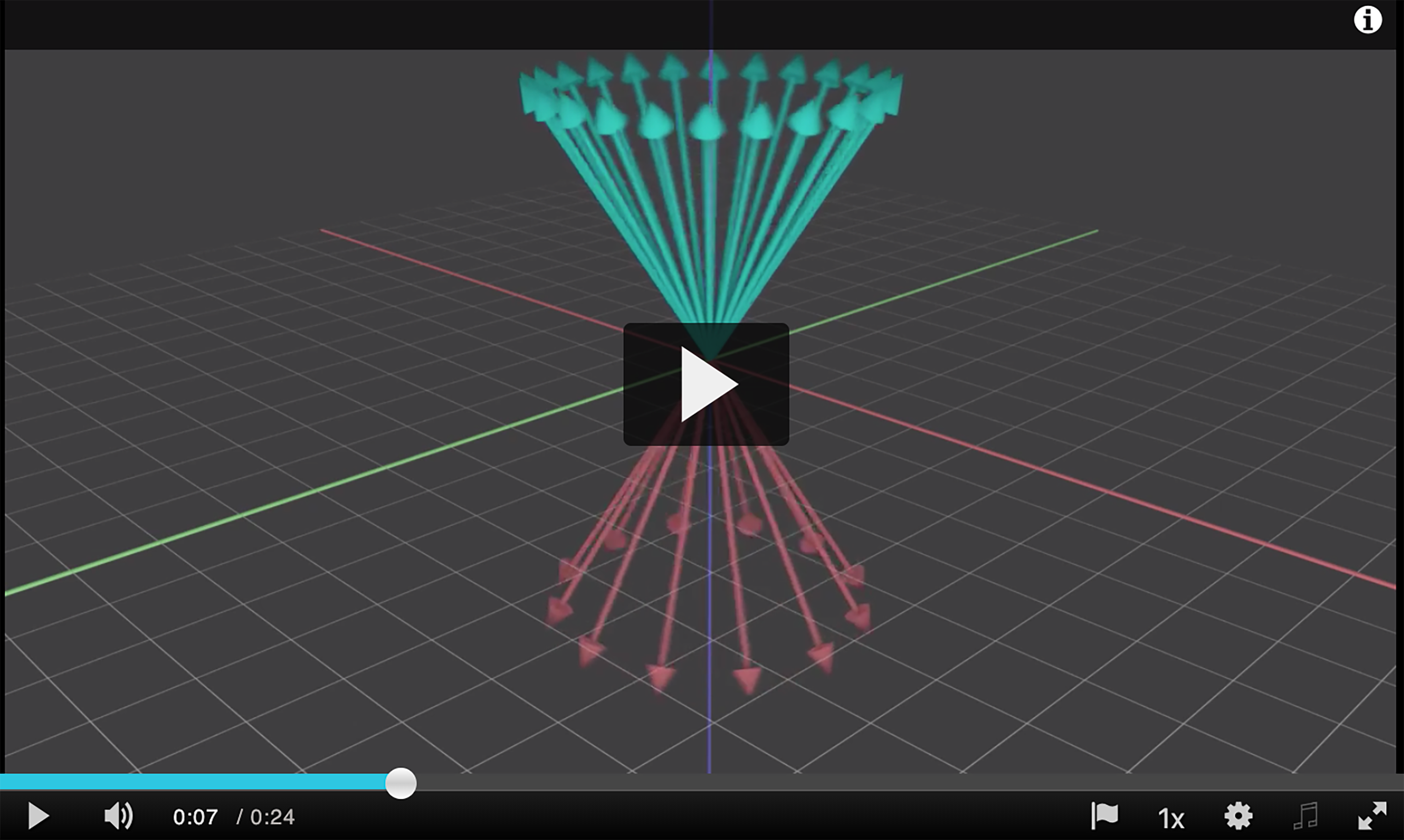
Image 4. Z-magnetization simulation in Macro-molecular Structure (instructor: Dr. Victor Hsu). Simulation visuals and videos created by Nick Harper, Media Developer at Oregon State University.
Multiple Means of Action and Expression In her third-year “Rangeland Ecology” course, instructor Yvette Gibson uses visually based learner-generated content (developed by former Ecampus media developer Mark Kindred) as the main teaching strategy for the course. Collectively, as a class, groups of students co-authored portions of the textbook and created resources that will be published for public use upon instructor approval.
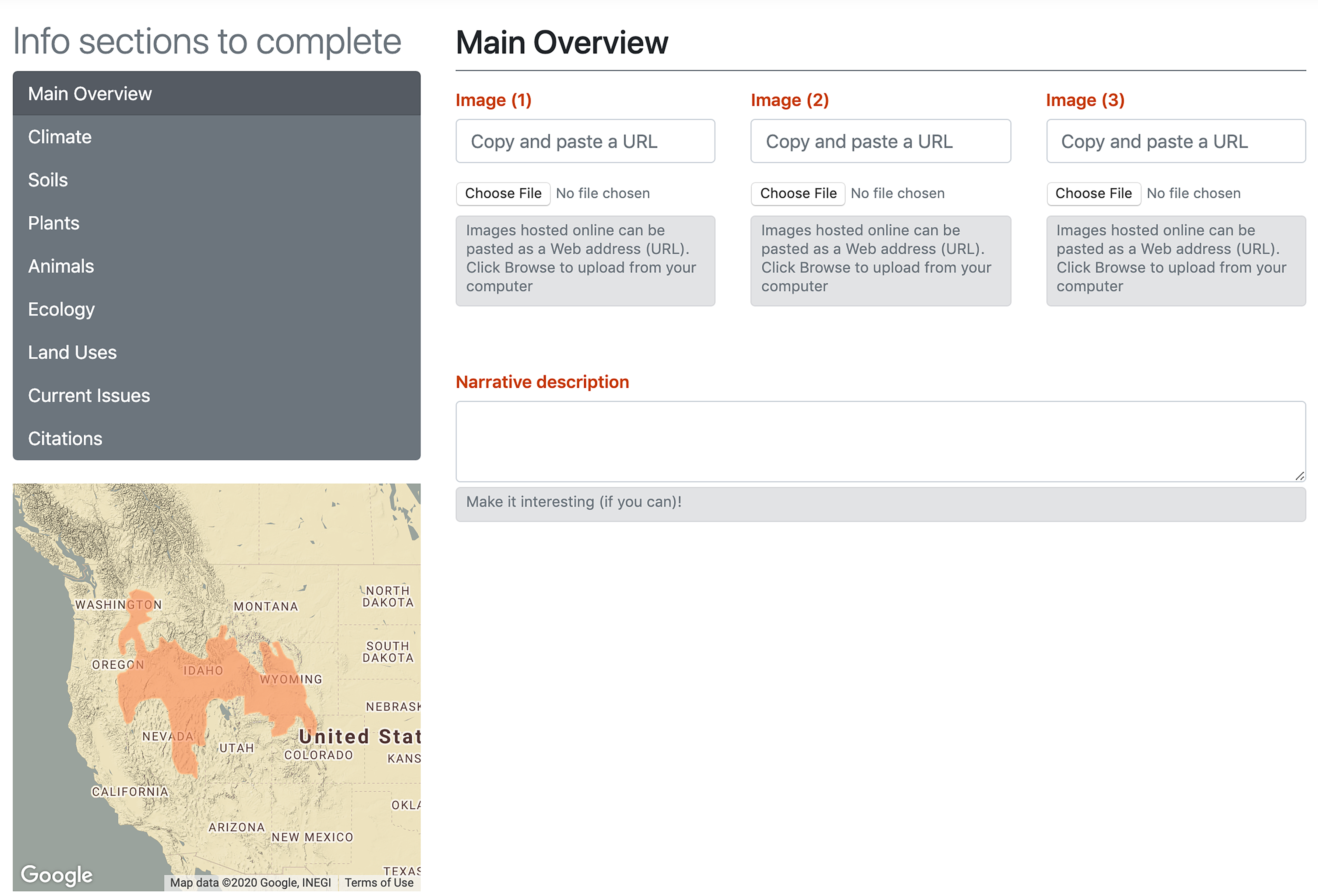
Image 5. Biography and ecosystem mapping (instructor: Yvette Gibson). Visuals and web interface created by Mark Kindred, former media specialist at Oregon State University Ecampus.
Multiple Means of Engagement
Bolliger and Martindale (2004) reported three major factors influencing student satisfaction in online courses: instructor variables, technical issues, and interactivity. Interactivity or engagement in an online course can happen in many formats, such as student-to-student engagement and instructor-to-student engagement. Student-to-student engagement can be implemented through a discussion forum, multimedia engagement tools such as Zoom or VoiceThread, paired partner interaction, small-group interactions, and large-group interactions. Instructor-to-student engagement can be fulfilled through announcements, discussion forum replies, and comments on submitted assignments in the form of text, audio, or video.
Instructor–Student Engagement
As Duckworth pointed out, constructive feedback toward mastery of skills and knowledge given in a timely manner is one of the key factors in deliberate practice. There are two major types of feedback an instructor can offer: individual feedback (an instructor message to a single student at a time), and whole-class feedback.
In online teaching, most instructors know it is important to provide individual feedback to students; however, whole-class performance feedback seems to be underutilized or unnoticed. John Hattie (2008) discovered, over decades of research, that feedback is one of the most powerful influences on achievement. Keeping in mind the extremely busy lives of online instructors, this chapter suggests a variety of ways to provide whole-class formative feedback at the end of a week’s grading.
Dr. Amy Bourne, an assistant professor and online instructor in the College of Business at Oregon State University, reviews students’ homework submissions and identifies areas where students are confused. Then she creates a Canvas page to be posted in the following week’s module, called “Week X Reflection,” to point out these challenging areas and direct students to resources that could help them learn.
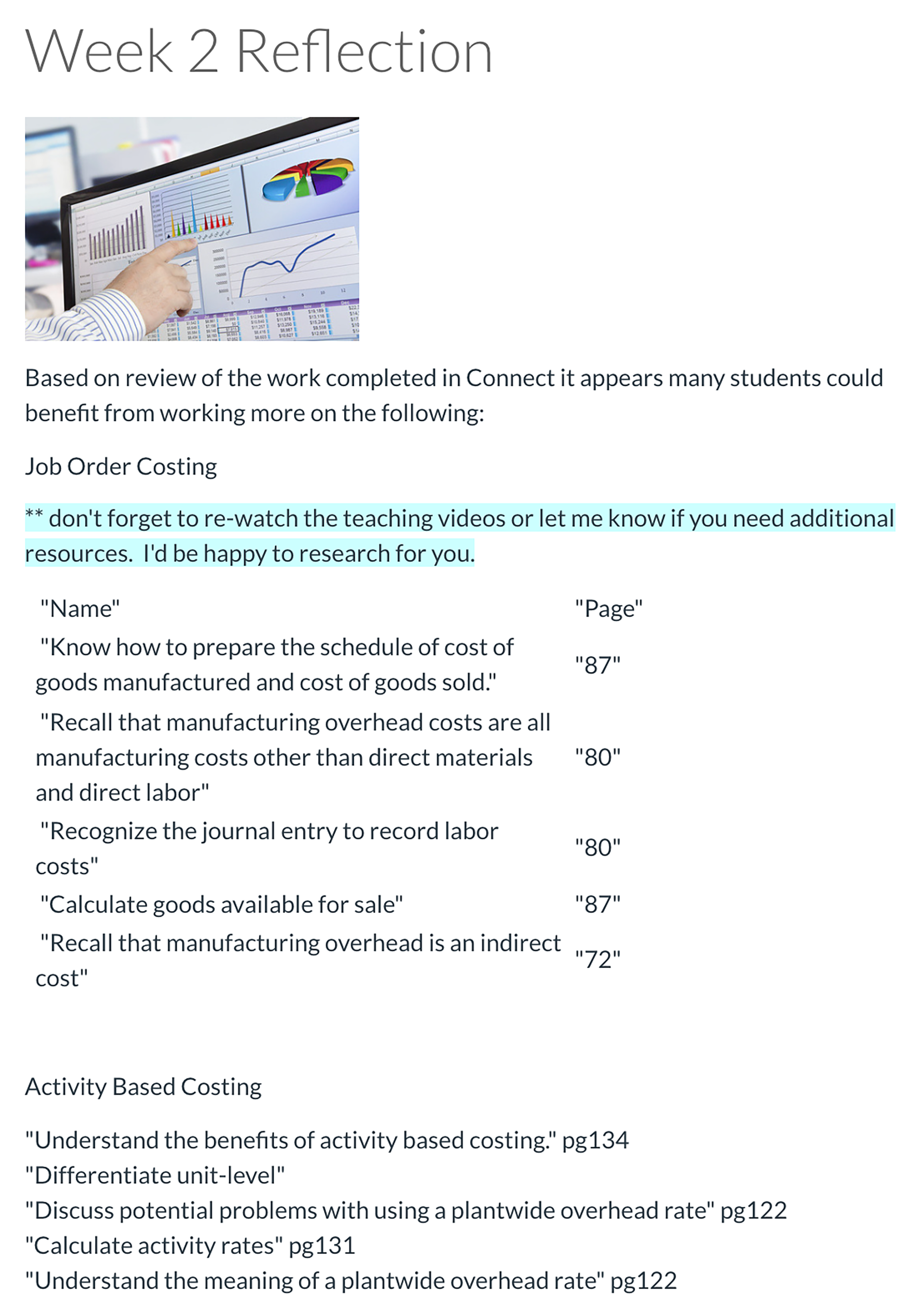
Image 6. Week 2 reflection page in BA 312 Managerial Accounting (instructor: Dr. Amy Bourne).
Michael Jerman, instructor of ECON 491, is interested in using video to do a weekly wrap-up and transition to the following week. Each message would summarize how students did that week in discussion forums and in assignments submitted. Image 7 is a screenshot from Michael’s Week 2 Overview page where his video messages will be hosted.
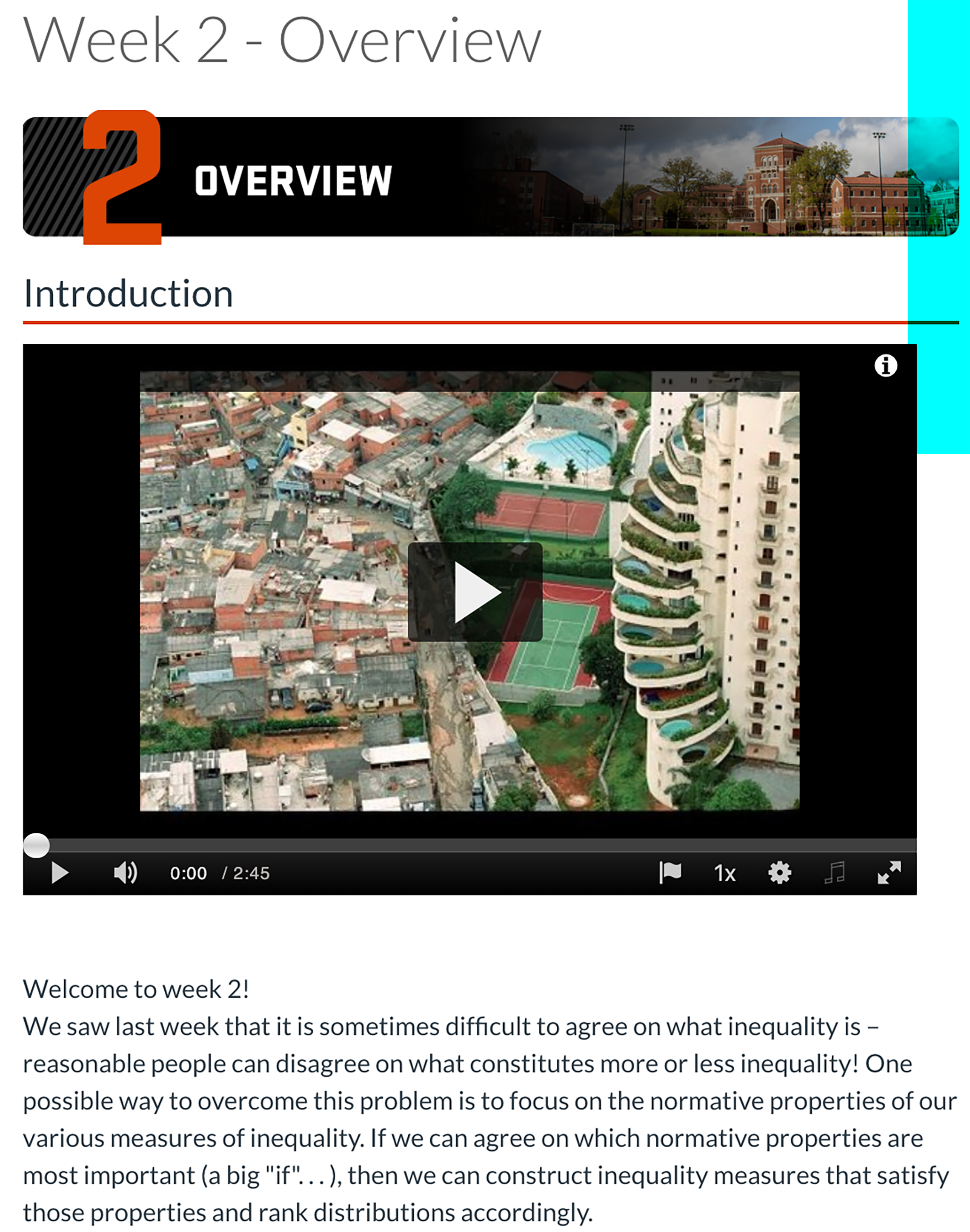
Image 7. Week 2 video recap in ECON 491 Economics of Inequality (Instructor: Michael Jerman).
The final example is from Dr. Leon Liegel, instructor of SOIL 511. Leon uses the weekly conclusion page to provide an analytical summary. He mentions the excellent work some students have done and contributed to the class, in the weekly journal writing submissions and weekly peer review discussions. He also posts all the topics of the final projects that each student has chosen to work on, so the whole class can get a broad view of what types of projects their classmates are working on, and maybe help each other or learn from each other.
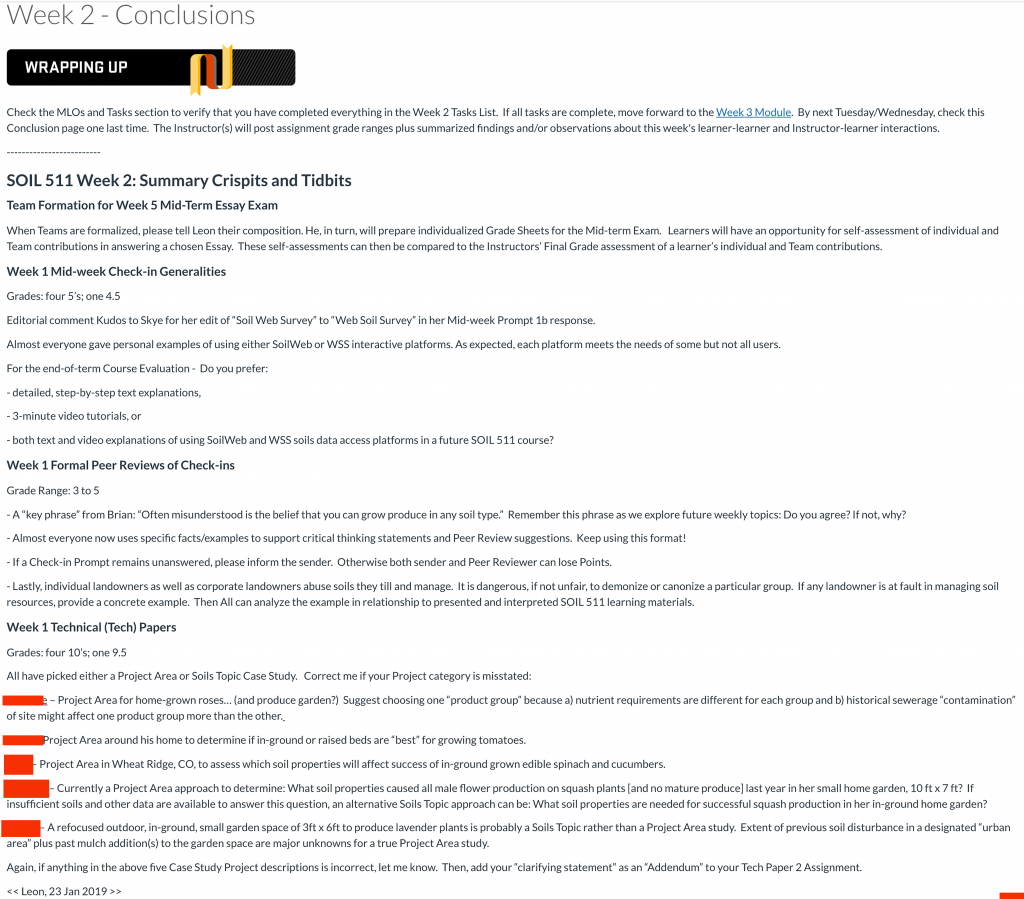
Image 8. Week 1 conclusion page in SOIL 511 Soil and Society (Instructor: Dr. Leon Liegel).
The above examples show that class whole-group feedback can happen in many different forms and serves many purposes:
- The instructor’s efforts to provide extra whole-class feedback create an engaging learning environment. Such feedback sends a message to the students that the instructor really cares about their learning success.
- This feedback directs students’ future learning focus or energy by pointing out areas for improvement, or areas where other students are performing above the class average level.
- It motivates students to do even better because their good work has been noticed and will continue to be noticed.
Online instructors who could not afford to provide feedback to students one by one may consider this strategy of group feedback to provide constructive feedback that builds mastery-type learning to enrich the students’ learning experiences.
Tools for UDL Implementation
Before choosing a tool for UDL implementation, it is important to take time to analyze and evaluate the needs of the instructor/training organization, the needs of the learners, the instructional objectives, the various tool options, and how each tool may align with the UDL principles and the neuroscience of learning (see Image 8).
Checklist before using a tool:
- ¨ What is my instructional objective?
- ¨ Does this tool help me achieve my objective?
- ¨ Does this tool aid in any of the following?
- o Multiple means of representation
- o Multiple means of engagement
- o Multiple means of action and expression (CAST, 2019)
- o Emotional environment for learning
- o Physical environment for learning
- o Motivation
- o Metacognition
- o Learning experience
- o Mastery of concepts, knowledge and/or skills
- o Extension and application of knowledge (Hardiman, 2012)
The following is a list of tools that the author has found useful:
- Text and responsive web pages:
- Visual creation on mobile devices and on laptop/desktops:
- o Canva;
- o Tagxedo;
- o Piktochart;
- o 3-D scanning;
- o com;
- o org;
- o icons from the Noun project, etc.
- Video-capturing on mobile devices and on laptop/desktops:
- o camera on mobile devices;
- o webcams,
- o Flipgrid;
- o 360 camera
- Audio:
- o audio/voice recorder from mobile devices;
- o Audacity;
- o Garage Band
- Voice animators:
- o Voki;
- o Animoji on iPhone X;
- o Doppel: Animated Emoji for All
- Screencasting:
- o Explain Everything;
- o Screencastomatic,
- o Jing
- Annotation tools:
- o iAnnotate;
- o Perusall;
- o is;
- o Markup app;
- o Google Docs;
- o inline grading in Learning Management Systems (LMS)
- Audience participation:
- o Padlet;
- o AnswerGarden
- Mindmapping tools:
- o mindmup;
- six other free tools for mindmapping (coggle, GitMind, Canva, InfoRapid KnowledgeBase Builder, and Sketchboard)
- Embedding questions in videos:
- o Kalture video quizzing;
- o EdPuzzle
- Interactive:
- o Kahoot!
- o H5P
- Polling/survey tools:
- o Poll everywhere,
- o Survey tools from LMS
- o mindmup;
UDL Resources CAST runs a subsite called “UDL ON CAMPUS” to host resources for UDL in higher education. The College STAR program offers free access to UDL-based teaching practices for faculty and staff members to implement in their college courses. College STAR also provides incentive funding for faculty members to join virtual learning communities and submit proposals to be developed into online modules and case studies. Table 2 provides a list of web resources and books on UDL.
Table 2. Universal Design for Learning resources.
|
Resource |
Description |
|
Best Practices for Designing Canvas Courses According to Universal Design for Learning: Condensed version |
Word document/ Web resource |
|
Implementing UDL on Canvas (K-12/HE) |
Free UDL course by Eric Moore |
|
Free UDL course on Canvas |
|
|
UDL in the Cloud!: How to Design and Deliver Online Education Using Universal Design for Learning by Katie Novak and Tom Thibodeau, CAST Professional Publishing (April 1, 2016) |
Book on UDL for online education |
|
Universal Design in Higher Education Promosing Practices, edited by Sheryl E. Burgstahler, S. (2013). Preface. In S. Burgstahler (Ed.). Universal design in higher education: Promising practices. Seattle: DO-IT, University of Washington. |
Book on UDL in higher education |
|
Unpacking the Digital Backpack for the Adult Learner—A Universal Design for Learning Approach, Sylvia Chong, SIM University, Singapore sylviachong@unisim.edu.sg Chong, S. (2015). Unpacking the Digital Backpack for the Adult Learner – A Universal Design for Learning Approcah. J. Lam et al. (Eds.): ICTE 2015, CCIS 559, pp. 10-22, 2015. |
Article on UDL |
|
Dirksen, J. (2015). Design for How People Learn. (2nd Edition). San Francisco, CA: New Riders. |
Book on learning and making it stick |
|
Centers for Disease Control and Prevention (infographics, web, print, videos, animations, text) |
|
|
What Is Universal Design (Centre for Excellence in Universal Design) (Ireland) |
Web resource |
|
About Universal Design for Learning (UDL) http://www.cast.org/our-work/about-udl.html#.WoSghnanHcs CAST: The UDL Guidelines |
Web resources |
|
Universal Design for Learning—The Teaching Commons: Georgetown University https://commons.georgetown.edu/teaching/design/universal-design/ |
Web resource |
|
Project Access—Colorado State University |
Web resource |
|
Reaching All Learners by Leveraging Universal Design for Learning in Online Courses |
Web resource |
|
Nine great concept mapping tools for teachers and students:https://www.educatorstechnology.com/2018/01/9-great-concept-mapping-tools-for.html bubbl.us, Popplet, MindMup, Creately, Coggle, MindMeister, Lucidchart, Mindomo, and Spiderscribe: https://www.digitaltrends.com/photography/where-to-download-public-domain-images/ |
Web resources |
|
Image-based visuals: Free icons for use from Noun project, emojipedia, Free visual/graphic design: Canva.com Royalty-free images: https://mashable.com/2017/05/23/where-to-find-royalty-free-images/#InWKQsKP0Oqa Creative commons, pixabay; Wikimedia commons images, IM Free, pexels.com, unsplash, dreamtime; NASA, Pexels, Flickr, |
Web resources |
|
Wordart.com; word cloud builders; Canva for creating visual aids and infographics; Microsoft Word, PowerPoint, and Publisher; Adobe Photoshop etc. to help create visuals or images
|
Web resources |
|
Concept maps: The concept map: a learning tool for any subject (Teaching Commons) The effect of concept mapping on students’ learning achievements and interests (research paper by Chei-Chang Chiou) Concept maps as a tool for meaningful learning and teaching in chemistry education (research paper by Mustafa KILIÇ and Murset ÇAKMAK) Why concepts, why meaningful learning, why collaborative activities and why concept maps? (research paper by Marco Moreira). Concept maps (Reading Rockets) Mapping Knowledge: Concept Maps in Early Childhood Education (research paper by Maria Birbili) Concept maps: Are they good for assessment? (Harvard Initiative for Learning and Teaching) Integrating Concept Mapping into Higher Education: A Case study with Physics Education Students in an Irish University (research paper by Joanne Broggy and George McClelland) Concept maps, a must for the modern teaching-learning progress (research paper by Ionana Stoica, Silvia Morary and Cristina Miron) Ten Good Online Tools for Creating Mind Maps (Free Technology for Teachers) Mind Mapping and Brainstorming Apps and Websites (Common Sense Education) https://www.educatorstechnology.com/2018/01/9-great-concept-mapping-tools-for.html (Great concept mapping tools) |
Web resources |
Keywords
remove barriers, Universal Design for Learning, UDL, UDL implementation, UDL principles, UDL resources, neuroscience, neuroscience-informed pedagogy, pedagogical foundation
Acknowledgments
Special Thanks to Irene Knokh for helping to compile some of the resources listed in this chapter, during our collaboration in Educause’s 2017–2018 ID2ID program.
References
Alexopoulou, E., & Driver, R. (1996). Small group discussion in physics: Peer interaction modes in pairs and fours. Journal of Research in Science Teaching, 33(10), 1099–1114.
Berg, A. (2016). ESSA and UDL. CAST Professional Publishing. Retrieved February 28, 2019, from http://castpublishing.org/essa-and-udl/
Bobek, E., & Tversky, B. (2016). Creating visual explanations improves learning. Cognitive Research: Principles and Implications, 1, art. 27. doi:10.1186/s41235-016-0031-6
Bolliger, Doris, & Martindale, Trey. (2004). Key factors for determining student satisfaction in online courses. International Journal on E-Learning, 3, 61–67.
Center for Applied Special Technology (CAST). (n.d.). CAST timeline. Retrieved from http://www.cast.org/about/timeline.html#.XHiF45NKh24
Center for Applied Special Technology (CAST) (2018). UDL and the learning brain. Wakefield, MA: CAST. Retrieved from http://www.cast.org/our-work/publications/2018/udl-learning-brain-neuroscience.html
Center for Applied Special Technology (CAST). (2019). About universal design for learning. Retrieved from http://www.cast.org/our-work/about-udl.html#.XRfI4JNKjx4
Cobb, P., Wood, T., & Yackel, E. (1993). Discourse, mathematical thinking, and classroom practice. Chapter 4 in E. A. Forman, Norris Minick, & C. Addison Stone (Eds.), Contexts for learning: Social cultural dynamics in children’s development (pp. 91–119). Oxford, UK: Oxford University Press.
Conger, K. (2013). Thomas Südhof wins Nobel Prize in Physiology or Medicine. Stanford Report, October 7, 2013. Retrieved from https://news.stanford.edu/news/2013/october/sudhof-nobel-prize-100713.html
Duckworth, A. (2018). Grit: The power of passion and perseverance. New York: Scribner.
Eryilmaz, H., Rodriguez-Thompson, A., Tanner, A. S., Giegold, M., Huntington, F. C., & Roffman, J. L. (2017). Neural determinants of human goal-directed vs. habitual action control and their relation to trait motivation. Scientific Reports, 7, art. 6002. doi:10.1038/s41598-017-06284-y
Eyler, J. (2018). How humans learn: The science and stories behind effective college teaching (1st ed.). Morgantown, WV: West Virginia University Press.
Fawcett, James. (2018). Geoffrey Raisman. 28 June 1939–27 January 2017. The Royal Society Publishing. Retrieved from https://royalsocietypublishing.org/doi/full/10.1098/rsbm.2018.0001
Florian, L. (2007). Reimagining special education, In L. Florian (Ed.), The Sage handbook of special education (pp. 7–20). London: Sage.
Florian, L., & Linklater, H. (2009, February 6–9). Enhancing teaching and learning: using “Learning without Limits” to prepare teachers for inclusive education. Paper presented to the American Association of Colleges for Teacher Education Annual Meeting, Chicago, IL.
Georgieva, M. (2013). Five minutes of fame. Retrieved from https://youtu.be/S-uZomkKOLc & https://www.digitalbodies.net/
Gruber, M. J., Gelman, B. D., & Ranganath, C. (2014). States of curiosity modulate hippocampus-dependent learning via the dopaminergic circuit. Neuron, 84(2), 486–496. Retrieved from https://www.cell.com/neuron/fulltext/S0896-6273(14)00804-6
Hardiman, M. (2012). Informing pedagogy through the brain-target teaching model. Journal of Microbiology & Biology Education, 13(1), 11–16.
Hattie, J. (2008). Visible learning: A synthesis of over 800 meta-analyses relating to achievement. New York: Routledge.
Hegarty, M., Carpenter, P. A., & Just, M. A. (1990). Diagrams in the comprehension of scientific text. In R. Barr, M. S. Kamil, P. Mosenthal, & P. D. Pearson (Eds.), Handbook of reading research. (pp. 641–669). New York: Longman: 1990.
Hoiland, E. (n.d.). Brain plasticity: What is it? Retrieved from https://faculty.washington.edu/chudler/plast.html
Jandhyala, D. (2017). Visual learning: 6 reasons why visuals are the most powerful aspect of elearning. Retrieved from https://elearningindustry.com/visual-learning-6-reasons-visuals-powerful-aspect-elearning
Kobayashi, Y. (1994). Conceptual acquisition and change through social interaction. Human Development, 37, 233–241. Library of Congress. (2000). Project on the Decade of the Brain. Retrieved from http://www.loc.gov/loc/brain/
Lieberman, M. D. (2012). Education and the social brain. Trends in Neuroscience and Education, 1(1), 3–9.
Loreman, T. (2017). Pedagogy for inclusive education. Oxford Research Encyclopedia of Education. doi:10.1093/acrefore/9780190264093.013.148
Max, D. T. (2016, January 25). One small step. A paraplegic undergoes pioneering surgery. The New Yorker, Annals of Medicine. Retrieved from http://www.newyorker.com/magazine/2016/01/25/one-small-step-annals-of-medicine-d-t-max
Mayer, R. E. (1989). Systematic thinking fostered by illustrations in scientific text. Journal of Educational Psychology, 81, 240–246. doi:10.1037/0022-0663.81.2.240
McGrath, B. (2018, April 26). Deep currents and dry creek beds: Sustainable UDL implementation. Presentation at UDL-IRN Summit 2018.
Meyer, A., & Rose, D. (1998). Developing reading engagement. Chapter 4 in Learning to Read in the Computer Age. (pp. 56-81).Wakefield, MA: Center for Applied Special Technology.
Moore, E. (2017). (K–12/HE) Implementing UDL on Canvas, a free online course. Retrieved from https://www.canvas.net/browse/utennessee-knoxville/courses/implementing-udl-on-canvas
Mueller, S., Wang, D., Fox, M., Yeo B., Sepulcre, J., Sabuncu, M., Shafee, R., Lu, J., & Liu, H. (2013). Individual variability in functional connectivity architecture of the human brain. Neuron, 77(3), 586–595. doi:10.1016/j.neuron.2012.12.028
National Research Council. (2002). Learning and understanding: Improving advanced study of mathematics and science in U.S. high schools. Washington, DC: The National Academies Press. https://doi.org/10.17226/10129
Nelson, L.L. & Basham, J.D. (2014). A blueprint for UDL: Considering the design of implementation. Lawrence, KS: UDL-IRN. Retrieved from http://udl-irn.org.
Novak, K. (2017). Why UDL. Retrieved from http://katienovakudl.com/why-udl/
Quality Matters. (2019). Course design rubric standards. Retrieved from https://www.qualitymatters.org/qa-resources/rubric-standards/higher-ed-rubric
Rosa, G. and Galvão, A. (2017). Differences of prior knowledge and study processes: interactions between level of expertise and learning. Acta Scientiarum: Education, 39(3): 319–328.
Rose, David H., & Meyer, Anne. (2002). Teaching every student in the digital age: Universal Design for Learning. Alexandria, VA: Association for Supervision and Curriculum Development.
Schwab, C. (2015). The Innovator of Universal Design, Mr. Ron Mace explained differences between Universal Design and barrier free in 1989. Universal Design Home and Accessible Design blog.
Shi, T. (2019). Twitter post on Demian Hommel’s use of curiosity gap. Retrieved from https://twitter.com/tianhongshi/status/1095772724436230144
Statista. 2019. Number of mobile phone users worldwide from 215 to 2020 (in billions). Retrieved from https://www.statista.com/statistics/274774/forecast-of-mobile-phone-users-worldwide/
Tobin, T. (2016). Brightspace webinar on Universal Design for Learning. Retrieved from https://www.slideshare.net/D2LBarry/brightspace-webinar-on-universal-design-for-learning-tom-tobin
Tobin, T., & Behling, Kirsten. (2018). Reach everyone, teach everyone: Universal Design for Learning in higher education. Morgantown, WV: West Virginia University Press.
Towns, M. H., & Grant, E. R. (1997). “I believe I will go out of this class actually knowing something”: Cooperative learning activities in physical chemistry. Journal of Research in Science Teaching, 34(8), 819–835.
UDL FOCUS. (2010). December 2010 issue of National Center on UDL’s UDL FOCUS newsletter. Retrieved from https://myemail.constantcontact.com/UDL-FOCUS—Welcome-to-the-first-issue.html?soid=1103889864977&aid=MUv3gYdVWIs
UDL-IRN International Summit. (2018). 2018 UDL-IRN International Summit schedule. Retrieved from https://2018udlirninternationalsummit.sched.com/
U.S. Department of Education. (2015). Office of Educational Technology, ed tech developer’s guide. Washington, DC. Retrieved from https://tech.ed.gov/files/2015/04/Developer-Toolkit.pdf
Verschure, P. F. M. J., Pennartz, C. M. A., & Pezzulo, G. (2014). The why, what, where, when and how of goal-directed choice: neuronal and computational principles. Philosophical Transactions of the Royal Society B: Biological Sciences, 369(1655): 20130483. doi: 10.1098/rstb.2013.0483
Volkow, N. D. (2010). A decade after the Decade of the Brain. DANA Foundation. Retrieved from http://dana.org/Cerebrum/2010/A_Decade_after_The_Decade_of_the_Brain__Compilation/
Wandersee, J. H., Mintzes, J. J., & Novak, J. D. (1994). Research on alternative conceptions in science. In D. Gabel (Ed.), Handbook of research on science teaching and learning: A project of the National Science Teachers Association (pp. 177–210). New York: Macmillan.
Ware, D. (2013). Neurons that fire together wire together. Retrieved from https://www.dailyshoring.com/neurons-that-fire-together-wire-together/
Wood, T., Cobb, P., & Yackel, E. (1991). Change in teaching mathematics: A case study. American Educational Research Journal, 28(3), 587–616.
